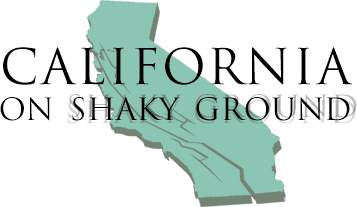
A UCMP short course
co-sponsored by the California Science Teachers Association
and the California Academy of Sciences
Commemorating the 100th anniversary of the 1906 San Francisco earthquake
Saturday and Sunday, February 4-5, 2006
UC Berkeley campus
On Saturday, geologists and seismologists examine the Bay Area’s seismic history, advances in earthquake science, the threat of tsunamis, and what’s being done to better understand how earthquakes work. A teacher workshop is scheduled for Sunday.
WEEKEND AGENDA
SATURDAY in 2040 Valley Life Sciences Bldg. (for the general public)
Parking information
8:15 am
9:00
9:10-10:10
Registration opens
Welcome
The Bay Area is at fault
Doris Sloan,
Earth & Planetary Science, UC Berkeley
The familiar mountains, valleys, bays, and coastlines that typify the San Francisco
Bay Area are the result of millions of years of seismic activity. Faulting continues
to change California and to rearrange the Bay Area's spectacular scenery.
10:20-11:20
The 1906 Earthquake — lessons learned, lessons forgotten, and looking forward
Mary Lou Zoback, USGS
Western Earthquake Hazards Team, Menlo Park, CA
The 1906 earthquake marked the birth of modern earthquake science. For the first time,
the effects and impacts of a major seismic event were systematically investigated and
documented. As earthquake science evolves, reanalysis of the 1906 earthquake data
continues to yield new insights about that event and the behavior of large strike-slip
faults in general. Looking to the future, a dense array of continuous GPS recorders
in northern California can inform us about fault interactions and behaviors that may
allow us to better predict earthquakes.
View the slides from Mary Lou's PowerPoint presentation here.
11:30-12:30
Tsunamis on the coast and in San Francisco Bay: Where will the next one come from?
Eric Geist, U.S. Geological Survey
Most people who live in the Bay Area are unaware that the San Francisco tide gauge station
has recorded 40 tsunamis over the last 150 years. The first tsunamis were recorded in 1854,
born from a pair of magnitude 8.4 earthquakes in Japan, spaced only 32 hours apart. Subduction
zone earthquakes located all around the Pacific "Ring of Fire" are the source for trans-Pacific
tsunamis striking the coast and entering the Bay; however, we also experienced our own
"home-grown tsunami" from the 1906 earthquake which told us about movement along the offshore
portion of the San Andreas fault.
12:30-1:15
1:20-2:20
Break for Lunch (on your own)
Scientific drilling into the San Andreas Fault
Mark Zoback, Geophysics,
Stanford University
The San Andreas Fault Observatory at Depth (SAFOD) is a project located near Parkfield,
CA that involves drilling into the San Andreas fault at a depth of 3 km where small earthquakes
repeatedly occur. The project has two principal objectives: (1) to build a geophysical observatory
directly within the active fault zone to precisely measure what happens before, during, and after
small earthquakes occur and (2) to address a wide range of questions about "how earthquakes work"
by making measurements and obtaining rock and fluid samples from within the active fault at depth.
2:30-3:30
Building a big picture: Multidisciplinary research in earthquake country
Anne Egger, Geological and
Environmental Sciences, Stanford University
Earthquakes along the San Andreas Fault dominate our views of hazards in California, but other
regions experience seismic activity as well. Recent research in the northeastern corner of
California, led to a fortuitous multidisciplinary collaboration between representatives from
local communities and government agencies and groups studying the geologic structure and history,
earthquake recurrence intervals, and geothermal resources of the region. This effort has helped
to drive new research and create educational and outreach opportunities in this remote region.
View information on Anne Egger's
field work.
3:30-3:45
A sneak preview of Aftershock! Personal Stories from the 1906 Earthquake and Fire
Aimee Klask, Associate Curator of History, the Oakland Museum of California
Commemorating the 100-year anniversary of the 1906 earthquake and fire, Aftershock! Personal
Stories from the 1906 Earthquake and Fire explores the first significant collision between
a California urban center and seismic activity and its devastation on San Francisco, surrounding
areas and individuals. Exhibition highlights include a shaketable simulating the 1906 earthquake,
a tent used by refugees of the quake and fire and 15 eyewitness accounts from those who
experienced one of the most important events in California history.
Link to more information on our speakers.
SUNDAY in 2063 Valley Life Sciences Bldg. (for teachers)
Parking information
A special workshop for teachers that includes a series of practical, standards-based, hands-on activities appropriate for grades six and higher. There will also be time for conversation, information-sharing, and lots of freebies.
8:30 am
8:50
Registration opens
Welcome and logistics
9:00-10:00
Landslides, Debris Flows, and Alluvial Fans: Hands-on dirt in the school yard
Simple hands-on experiments using relative low cost and easy-to-acquire materials,
presented by Phil Stoffer, US Geological Survey.
10:10-11:10
Finding faults
A series of hands-on activities appropriate for grades six and up presented by Richard Sedlock,
Bay Area Earth Science Institute and the Department of Geology, San Jose State University.
11:20-12:20
Schoolyard Geology
Presented by Matt d'Alessio, US Geological Survey. Find more on this topic at this USGS site developed by Matt.
12:20-12:30
Freebie give-away!
Professional Development Opportunity for Teachers
Please note that both Saturday and Sunday qualify toward your professional development. There are two opportunities for teachers:
- We will provide you with a certificate of completion of professional development hours for each day of attendance.
Saturday and Sunday both qualify as part of a new Extended Professional Development Program sponsored by CSTA. For each set of 15 hours of instruction, you can earn one unit of upper division geology credit through San Jose State University. Please see: http://www.cascience.org/EPD.html.